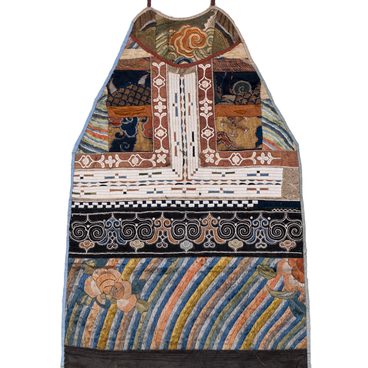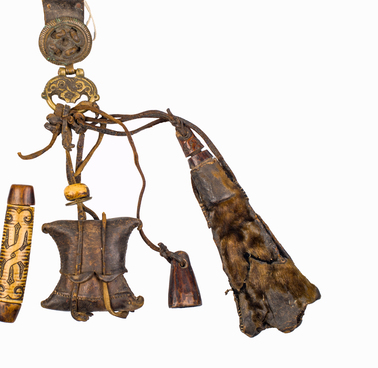Shamanic ritual clothing of indigenous peoples of the Khabarovsk Krai has its own peculiarities and differences. The main elements of the shaman’s costume of the Amur region’s people were a blouse with a skirt or an open robe, on which images of spirits — the shaman’s helpers — were applied in various ways.
Most often they were drawn on cloth or deerskin, or were executed in appliqués. Besides, many colored rags symbolizing wings and feathers of birds were sewn on shamanic clothes. In the past, the Udege people sewed not rags, but bird feathers to the shaman’s costume.
Traditionally, the representatives of this people sewed robes of white cloth. Their distinctive feature was the numerous images that filled most of the surface of the garment. The robe on display has images of sacred animals: tigers, birds, snakes, lizards and human figures.
The Udege people exalted the tiger to the rank of a deity and prayed to him. For example, when the Udege people of the Anyui River discovered a tiger track in the taiga, they counted seven footprints of the beast, knelt down and asked him to send them good luck in fishing.
In the center of the robe back there is an image of a marine animal: a whale or an orca. The Udege people had a ritual of honoring these inhabitants of the sea depths. In the traditional culture of the Amur and Sakhalin peoples the orca was revered as an ancestor of people. The Udege believed that the sacred orca could emit light from its white belly and shout like a human being. It was forbidden to eat meat of whale and orca.
When meeting them in the sea, fishermen had to throw sacrificial gifts such as food, tobacco, matches, and ramson into the water. The Udege believed that Sugzya azani, the master of all fish and sea animals, sent an orca to drive a certain amount of fish into the rivers during fishing.
The shamanic clothing
and accessories always included a hat, a belt with metal pendants, a tambourine
and a mallet. A special staff, tavogda stones, bronze toli mirrors and numerous
savans — sculptural embodiments of helping spirits — were additional elements.
This shaman’s robe was handed over to the Grodekov Museum by the Udege people
from the Khor River area in 1946.





